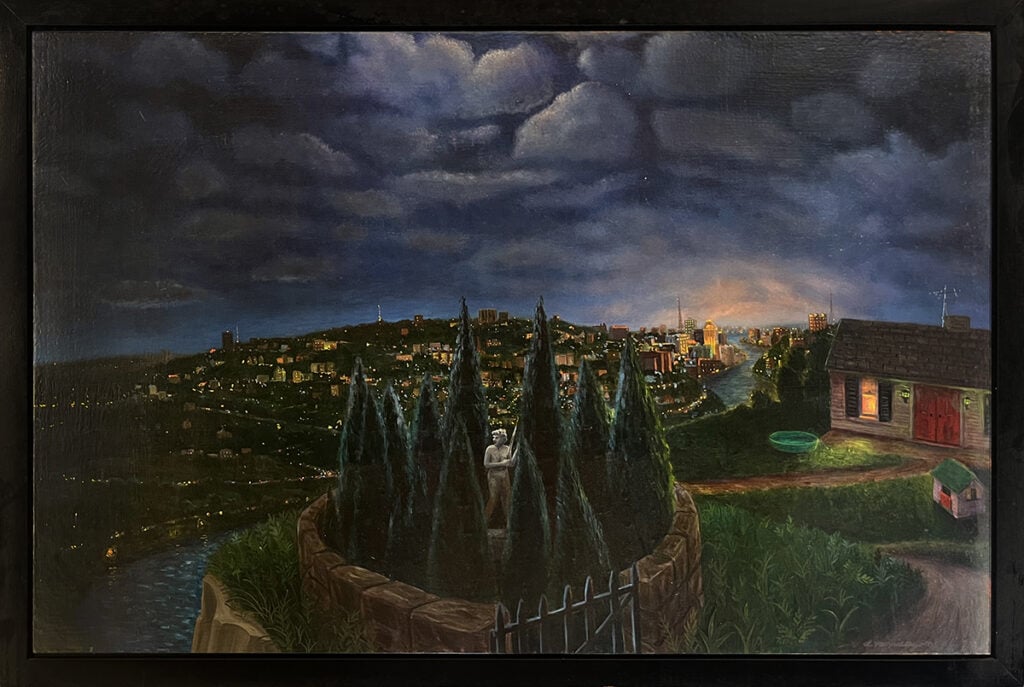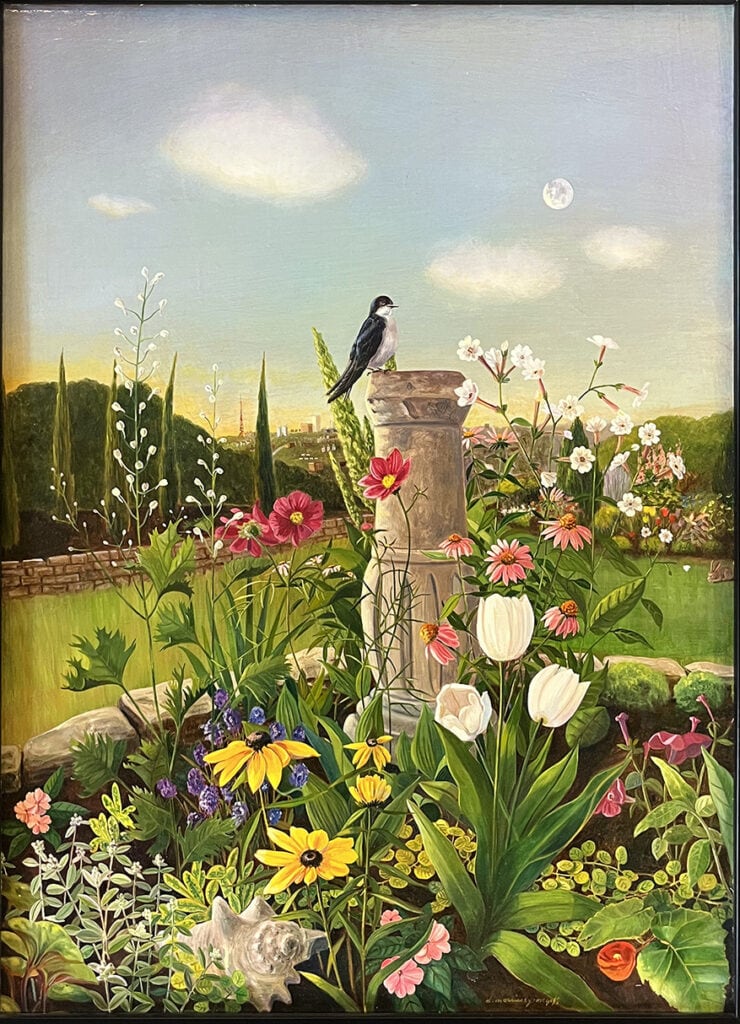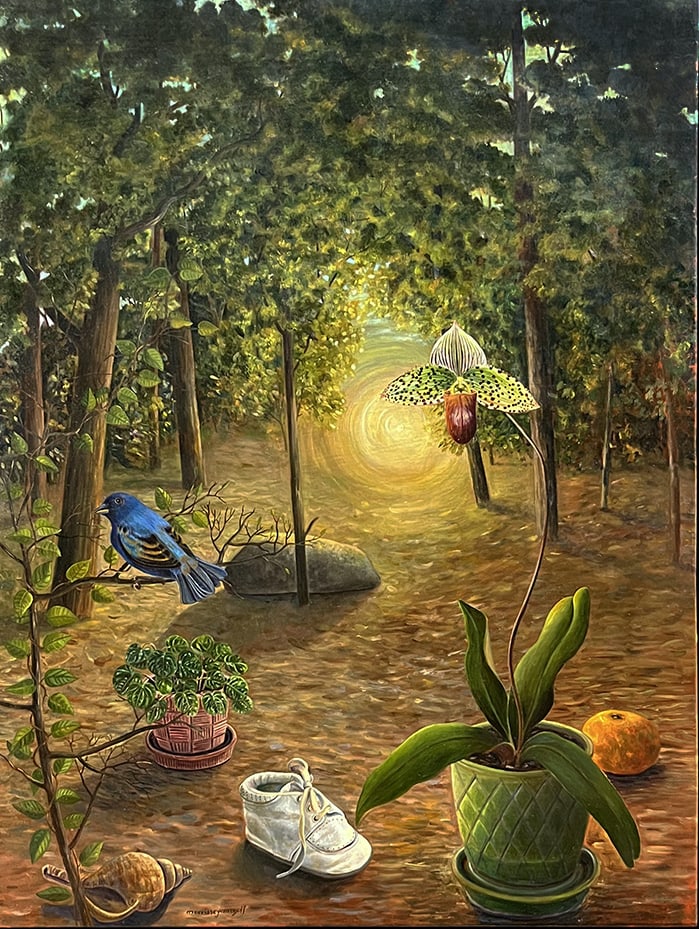Deborah Morrissey McGoff (1955-2022), a prodigiously talented and beloved painter, trained in drawing and printmaking at the University of Cincinnati and mainly self-trained in painting and color theories. Her enigmatic landscapes are painted in oil on traditionally prepared panels, a time-intensive process using a gesso recipe dating (with little variance) to the 13th century. Additionally, her compositions utilize classic and literary thematic references, thus doubly linking back to the landscape idioms and techniques from the Italian Renaissance to the Hudson River School. Her goal in this prolific production is thus summarized in her own words:
“The paintings are invented spaces where I manipulate time and perspectives to accommodate my thoughts concerning a variety of subjects. These “narrative landscapes” may include gardening, solitude, sanctuary, urban contrasted with rural life, Eden, or homage to an artist who has inspired me.”
It has been noted by curators of past exhibitions, that she has succeeded in capturing the beauty and power of landscape as an emotional and dramatic messenger. This survey will impress you with the range and depth of Morrissey McGoff’s prolific output and her continual artistic development over several decades.

A work inspired by a hunting scene painted by Lucas Cranach the Elder, 16th century German Renaissance artist, is entitled “Life, Long after Lucas Cranach the Elder” 1990. Under a lowering sky, an antlered buck struggles to navigate a turbulent, polluted river to join his companion resting on an untainted grassy island, encircled on all sides by a simmering man-made dystopia. Though man’s allegiance to God is evidenced by the multi-steepled complexion of his community, foul waste can be seen actively being pumped into nature’s raging waters.
The safety and well-being of family and issues of privacy and boundaries are key elements explored in McGoff’s paintings. In several pieces, McGoff’s imagery addresses her personal anxieties about the well-being of her impetuous daughter, Emma. In “Undertoad,” the painting is divided into two realms: the busy complicated ever-expanding metropolis and the quiet security of the rural environment. The meandering river separates the two worlds and flows peacefully toward a brilliant sunset, ever the harnessed faithful servant of industry and commerce. All seems well. In the foreground, the house set upon the craggy hilltop, is a solid sanctuary in which the family will flourish. Spear-like cypresses surround a fountain, the waters of life cascading from the hands of a benevolent venus. Pool and playhouse accent the backyard which also supports a self-sufficient garden and evidence of leisure time. But danger lurks in this bucolic setting. A bike belonging to the child of the realm, dangles dangerously at the edge of the craggy cliff despite the watchful presence of the loyal family dog.


In the painting Night Garden, the cypress spears have closed ranks and the gated garden is encircled by a formidable stone wall. The stone venus is now a maiden embattled and, armed with a drawn sword, she casts a wary eye over her shoulder. Beyond the heedful cypresses, the hot lights of the city emblazon the horizon as far as the eye can see under a beclouded and starless night sky.
A central gallery is devoted to several paintings of McGoff’s personal garden. Much loved and well attended, her garden celebrates nature’s companionship in varietal botanical glory. The presence of several species of birds and insects and evidence of the sea in shell and conch findings underline the industrious efforts of this gardener.


McGoff’s garden motif also serves as a parable narrative. In the painting “For Mother,” the garden pathway is strewn with potted plants, a stone, a shell. At the edge of the not too distant treeline, a brilliant spinning light beckons us onward. Facing the viewer on the right, a regal spotted trumpet orchid, wearing its petals like a floral diadem, engages our attention and exhibits a beckoning posture. Its foliage radiates from its potted base, seemingly alarmed and agitated by the single lost leather-soled baby shoe nearby, bringing it to our attention with its tentative touch. The painting may be a statement about the of loss of a child and the burden of guilt and mourning that is never resolved going forward.

Several paintings are decades in the forefront calling for environmental reclamation and forecasting the bleak prediction of nature’s destruction. Morrissey McGoff’s “Frankenstein” 1990 is one such work. On the earth’s surface (which is less than 20% of the vertical height of the painting) the tones are no longer lush and verdant. The waters of the river are contaminated and several factories are seen belching chemicals into the atmosphere. Nature’s response, a writhing violent cloud, is rapidly ascending into the open heavens, threatening to wreak havoc on the unwary below with irreversible consequences to follow. “Frankenstein” 1990 and “Legacy” 1988 are powerful indictments on the effects of industrialization and pollution on the fragile ecosystem.
These remarks represent a sampling of the variety of themes and personal insights depicted in this remarkable body of work. The arresting, contemplative quality of Morrissey McGoff’s paintings achieve her goal of establishing dialogue between the past and the present, explored through the lens of her personal experiences and life cycle events, her self-reliance and solitude as an artist.
Exhibition at Cincinnati Art Galleries through June 17th, 2023